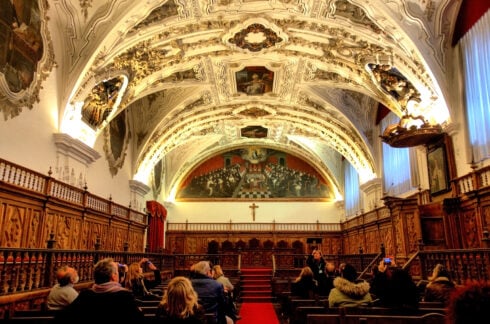FROM the palaces of Spain to the cathedrals of colonial Mexico and the revivalist flair of early 20th-century California, the Churrigueresque style dazzled with theatrical excess and sculptural extravagance – a brief but unforgettable flourish in architectural history.
It doesn’t matter if you find the style to be beautiful or hideous.
From about 1680 until 1750, this extremely intricate design trend was popular in Spain. The Spanish colonies (notably Mexico) were the first to adopt it, but almost nowhere else.
Churrigueresque is a branch of the Baroque tradition – in fact, one of its most flamboyant and decorative expressions. Churrigueresque, while Baroque architecture was known for its drama, richness and flamboyance, took these qualities to the extremes. This is especially true in its treatment on portals, facades, and altars.
It is rarely found on walls with flat surfaces, as it relies heavily on detail. The most common place to find it is on doors, as they are easier for artists to work.
What is the origin of this bizarre architectural form?
Jose Benito de Churriguera died in 1725. Joaquin, Alberto and he were all freelance craftsmen and architect working in Salamanca, Madrid and other cities.

What Jose and his family were striving for was not ‘rustication’ (which refers to rough, textured masonry), but rather a radical reworking of classical ornamentation – manipulating columns and entablatures into dramatic, sculptural forms that some would call grotesque.
The brothers were able to capture the spirit of the times. As they received more and better contracts, their designs reached new levels of ornamentation.
The work of these artists is still visible in Salamanca as well as parts of Madrid. Even briefly, they made it to Andalucia where they planned and built the facade of San Telmo Palace, Sevilla and an enormous altar in Santa Maria la Mayor, Ronda.


Mexico has some of the most outstanding examples of Churrigueresque. Both the Cathedral of Zacatecas in Zacatecas as well as Santa Prisca, Taxco are excellent examples.
Often, Mexican churches such as the Parroquia Antigua de Guanajuato remained unfinished for a long time. These were often finished in grand style during the 18th century as money became more available.
The Jesuits, who were expelled in 1767 from Mexico and the other Spanish territories, left behind a legacy of institutions, funds, and architectural designs that contributed to the construction boom in the churrigueresque design.
Improbably, this highly ornate ‘look’ made it into the 20th century.
In 1915, there was a Panama–California ‘expo’, at which two American architects made playful forays into the Spanish–Mexican format, triggering a new craze.
Bertram Goodhue and Carleton Winslow developed ‘California Churrigueresque’, and many of their buildings still stand today in the city of San Diego.


Could this style ever come back?
We are reluctant to say ‘never’, but it seems unlikely. Modern materials don’t lend themselves well to detailed modelling.
Modern owners are also cost-conscious and don’t place a lot of importance on ornamentation.
Most important of all, churrigueresque was a form of ‘trompe l’oeil’ – an attempt to convince the observer that heavy stone is a light and nimble material.
Today, we are building lightly. The style of this elaborate building is outdated and does not serve any modern purpose.
READ MORE
Read more Property News at The Olive Press by clicking here.
 Costa News Spain Breaking News | English News in Spain.
Costa News Spain Breaking News | English News in Spain.





